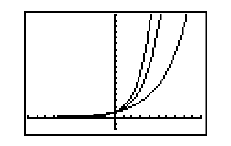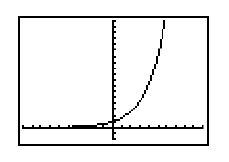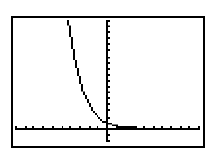Exponential Functions
Laws of Exponents
If s, t, a and b are real numbers, with a > 0 and b > 0, then:
1) as · at = as + t
2) (as)t = ast
3) (ab)s = as · bs
4)

5)

6)

7) 1s = 0
8) a0 = 1
Exponential Functions
Definition: If b is a positive real number, b ≠ 1, the exponential function with base b is f(x)
= bx , for every
real number x.
Examples:
Properties of Exponential Functions of the Form f(x) = bx
1. bx > 0 for all numbers, x; so, the range of these functions is (0,
∞).
2. Their domains will be (-∞,
∞).
3. All will have y-intercepts at (0,1) and no x-intercepts.
4. The x-axis is a horizontal asymptote.
5. If b > 1, f(x) = bx is an increasing function. If 0 < b < 1, f(x)
= bx is a decreasing function.
6. They are all one-to-one.
Here is a graph with f(x) = 2x , f(x) = 3x and f(x) = 4x all on the same screen. Can you tell which is which?

The Natural Exponential Function: f(x) = ex
e is a special number in mathematics, and is approximately 2.7182818. Since e
> 1, the graph of the exponential function is shaped like the graph of f(x) = 2x. It is an increasing function. ex
> 0 for all numbers x. Here is the graph of f(x) = ex:

| Exponential Growth Functions Any function of the form
y = a(bx), b > 1, a > 0, is an exponential growth function. Its graph will increase on its entire domain.
|
Exponential Decay Function Any function of the form y
= a(bx), b > 1, a > 0, or y = a(c ), 0 c 1, a 0, is an exponential decay function, and will decrease on its domain.
|
 |
 |
|